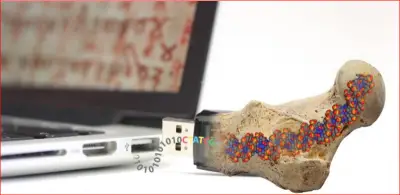DNA is known to pass data from one generation to other for ages. People’s basic nature and resistance to diseases etc are transferred via DNA. You all know about that. But did you know that DNA could be used to store digital data as we store it on Hard Disk Drives?

Using DNA to store digital data
Science now has DNA based hard disk drives that use DNA to store data. One gram of DNA can store approx. 450 Exabyte of data. That would be equal to roughly some billion gigabytes. As a result, these are mini hard disk drives that work based on DNA (probably preserved in bones unlike the magnetic platters) and can store vast amounts of data for million years or more.
Normal data storage devices use the binary coding to store data. For DVDs, it was lands and pits depicting 1s and 0s. For hard disk drives, it is still the scratches on the magnetic disks that take form of 0s and 1s.
In DNA-based storage, the genetic sequences are used to generate the 0s and 1s required to store the required data. This would need a little biological information. But to cut it short, DNA has two pairs of data storage that determines the personalities of people. There is a pair called A and C. Another pair is T and G. Biologically, their function is different but coming to computer science, the A and C pair is taken as 0 while the T and G pair is taken as 1. That solves the binary issue and helps in storing gigabytes of gigabytes of information for millions of years.
Of course, the storage conditions will affect the device which could be nothing more than a digitally connected bone or something like that. The storage conditions should be ideal – as in fossils – to preserve data for a long time and to prevent it from being corrupted. It is being said that such devices would be available for around $1500 per Exabyte of storage. While regular computing users may not feel the need for such storage devices, it would be ideal for libraries such as Library of Congress and other places where plenty of data is involved.
Sounds like something out of an Alien movie …… LMAO!